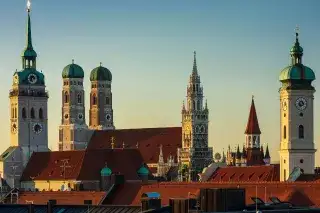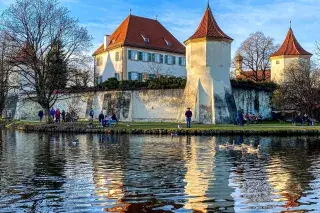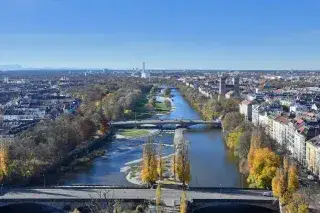The Theresienwiese square: The most famous "meadow" in Germany
The Munich Theresienwiese - the Oktoberfest location and more
Theresienwiese is the world famous location where the Munich Oktoberfest is held. The locals also like to come for the Spring Festival and Winter Tollwood to celebrate here. But the Bavaria and St. Paul's Church also add to the charm of Theresienwiese. And when there is not an event taking place, the square is used by the people of Munich for leisure activities.
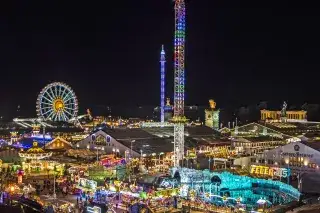
More actions
The Theresienwiese at a glance
- Area: 42 hectares, roughly 60 soccer fields
- District: Ludwigsvorstadt
- Location for events like: Oktoberfest, Munich Spring Festival, Giant Flea Market, Oldtimer Festival, Winter Tollwood, Bavarian Central Agricultural Festival (Bavarian Central Agricultural Festival, every four years)
- Things to see and do: Bavaria statue and Ruhmeshalle, St. Paul's Church
- History: Named after Therese von Sachsen-Hildburghausen, the wife of King Ludwig I, since 1810 - the first Oktoberfest was held on the occasion of their wedding
- Nickname: No one from Munich goes to the Oktoberfest. They go to the „Wiesn". The Bavarian form of the German word „Wiese" („meadow") has become the name of the festival for the people of Munich and Bavaria.
Munich’s largest public festival space for major events
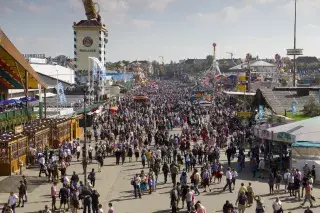
Great events are held on the Theresienwiese all year round:
- The most important is, of course, the Oktoberfest , which begins in mid- to late September and lasts a little more than two weeks. Construction for the world's largest public festival begins as early as mid-July.
- Munich's folk festival season starts even earlier - in April with the two week-long Frühlingsfest (Springfest), also known as the "little Wiesn."
- In its supporting program, the Riesenflohmarkt (Giant Flea Market) - the largest in Bavaria - invites you to take a stroll and browse the wares on offer.
- The spectacular Oldtimerfestival (Classic Car Festival), with more than 1,000 historic vehicles takes place on the first Sunday.
- In December, the numerous tents and colorful booths of Tollwood (a month-long alternative cultural festival) are set up.
Bavaria and St. Paul’s Church - two fantastic viewing points
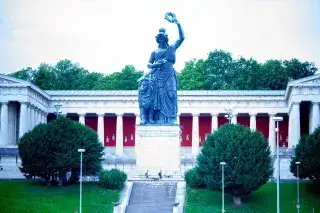
Two elevated spots offer the best views of the hustle and bustle on the Theresienwiese. One is the Bavaria, a nearly 18 meter-tall statue embodying the female symbol and patron saint of Bavaria. She is enthroned, visible from afar, in front of the Ruhmeshalle (Hall of Fame) on the side of the slope. Inside the statue, a spiral staircase leads to the Bavaria’s head, where four small hatches offer a view of the Theresienwiese.
Even taller is the tower of St. Paul’s Church, north of the Theresienwiese. Oktoberfest attracts legions of visitors to the viewing platform at the main tower, up where the famous postcard view of the entire Wiesn opens up with the Alps in the background. However, the tower is only open during Oktoberfest.
Plenty of space for hobby sports on the Theresienwiese
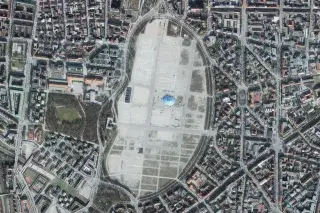
Despite its name, the Theresienwiese, with its huge open area of 42 hectares, has no significant greenery. But its sheer amount of free space in the middle of the city has plenty of advantages: A skatepark, basketball court, and a few sports fields can be found at the edge of the area.
Many inline skaters and small children with bicycles make their first attempts on wheels on the wide, car-free roads.
In fall especially, the unobstructed terrain entices legions of fans of kites and hang gliders, who can here indulge their hobby in relative safety and peace.
How the Theresienwiese got its name
For a long time, the Theresienwiese was nothing more than grassland at the gates of Munich. Until October 17, 1810, when Bavarian Crown Prince Ludwig, later King Ludwig I, organized a horse race on the meadow as part of his wedding to Princess Therese of Saxony-Hildburghausen.
Around 50,000 spectators watched the race on a slope above the meadow, which was named "Theresiens Wiese" (Theresien's Meadow) in honor of the bride with royal permission. The following year, a follow-up race was organized. Thus was born the tradition of the Oktoberfest.
